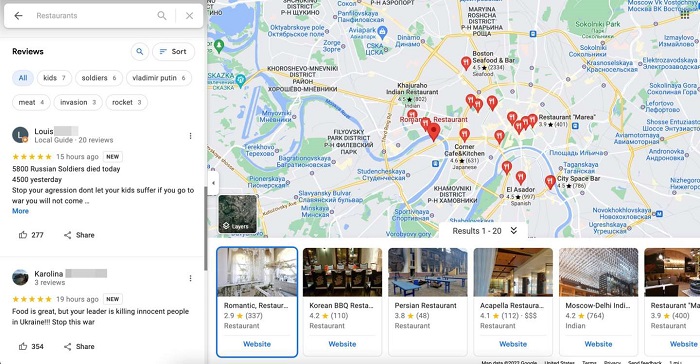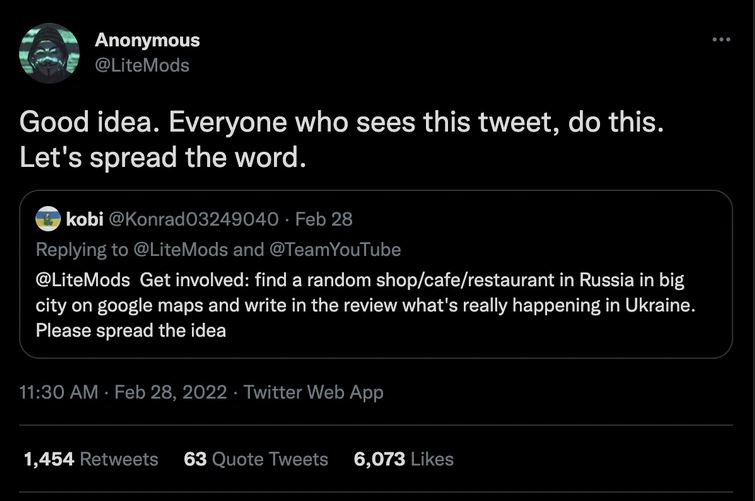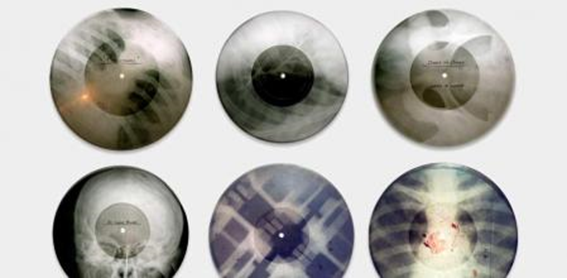RAFAEL GÓMEZ DE PARADA / FINANCE AND ADMINISTRATION DIRECTOR AT SACYR SERVICES
After the invasion of Ukraine, perpetrated by the Russian army, Vladimir Putin has intensified his iron grip on information in the country that he has led for the past two decades to diffuse internal rebellions. He is especially keen on trying to control every publication about the war to keep Russian citizens in the dark about what is really happening in the neighboring country.
Some Ukrainian citizens, as well as Russians that reject Putin’s regimen managed to dodge censorship by posting messages on social media or reviews on websites like Trip Advisor and Google Maps to get the information through to the Russian people:

If someone were to look up a restaurant with good reviews in Moscow or St. Petersburg and they would find a review that said something along these lines: “Food was great! Unfortunately, Putin spoiled our appetites by invading Ukraine. Stand up to your dictator, stop killing innocent people!”
As a response to the strict censorship enforced by Putin’s office, Google Maps and Trip Advisor decided to disable these ‘subliminal’ messages about the war, and almost simultaneously, on March 14, the Russian government blocked Instagram, claiming the platform had been used to disseminate terrorist propaganda and incite violence against Russian citizens”.
The censorship, and the people's creative response to find innovative solutions to dodge it are heavily reminiscent of Ruslan Bogoslowski’s story. Bogoslowski was a sound engineer who managed to bootleg Western music in the Soviet Union in the 1950s and 1960s.
In the late 1940s, Stalin enacted a law to control Soviet musicians, as well as any music distributed because he considered all artistic expression to be related to politics. In actuality, his goal was to limit all Western influence, as he thought that European and American music disseminated “capitalist” or “anticommunist” ideas. Despite Stalin passing in 1953, the law remained in force for decades.

Young Bogoslowski, living in Leningrad (current St. Petersburg) managed to bootleg hundreds of thousands of copies of jazz, blues, or rock&roll records. He had the technology to do so, but he lacked a material on which to carve the records. Vinyl, as a by-product of petroleum, was very expensive, and the access to it was limited and government-controlled.
Bogoslowski had tested multiple materials until he came across the solution when he found some x-ray films in a garbage can next to a hospital. At the time, x-rays were disposed of in the trash due to their being highly inflammable, so Bogoslowski could easily find them.

The process of producing the illegal records was handmade, extremely improvised: the x-rays were cut into a circle shape by hand and the hole in the middle was burned with a cigarette. The sound quality was not great, but the records were well received among the Stylagi, the Soviet hipsters of the time.
Duke Ellington, Louis Armstrong, Billie Holiday, Thelonius Monk… and the most requested, the Beatles. The records were exchanged for a few rubles, food, or warm clothes. It is estimated that Bogoslowski and his circle bootlegged close to a million records using this method for nearly 20 years.
Due to the x-rays having images of skulls, tibias, or ribcages on them, these records were known as music on ribs, bone music, or bones & ribs. In 1959, the Soviet regimen strengthened its ban on music even more to persecute those who circulated forbidden music, and that is how Ruslan Bogslowski was identified as the promoter of the bootleg copies, and then sentenced to six years of hard labor in Siberia. Some of these records can still be listened to here:
